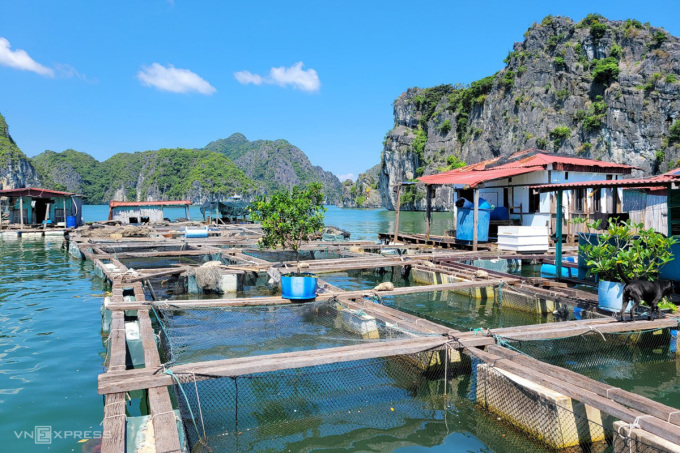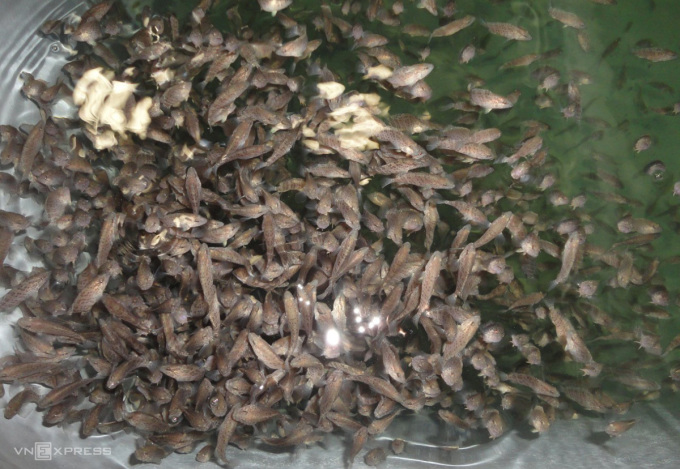Fish market meeting at 1 am along Bai Tu Long Bay
QUANG NINH – Over midnight, hundreds of small traders flock to Ben Do fish market to buy seafood from
HAI PHONG – A fish raft with an area of about 3,500 m2 located on Lan Ha Bay, is a place to preserve and provide varieties of 16 rare and valuable fish species with high economic value to the people.
At 6 am every day, when fishing boats of fishermen on Lan Ha Bay, Viet Hai commune, Cat Hai district, return to the wharf, Mr. Pham Van Thin, 47 years old, an officer of the National Center for Northern Seafood Seeds, comes out. receive food for precious fishes being conserved and kept in floating rafts located in the middle of the Tung estuary on Lan Ha Bay.
Mr. Thin and two colleagues walked on the ice on wooden trees only 20 cm wide, carrying two buckets of fish full of fish, weighing tens of kilograms. “We can do weight training every day thanks to this job. The biceps are as big as bananas,” said Mr. Thin, laughing. Go to the plate about 20 m2 wide, Mr. Thin poured out the fish, all of which were as small as a finger. After that, he sorted and moved to each cage to feed the fish.
Sticking with fish rafts on Lan Ha Bay for many years, Mr. Thin understands the behavior of each species. Currently, the raft keeps 16 species of fish, including 8 species of grouper (brown dot, flat, rat, tiger, king, hybrid, lemon, leopard), cobia (sea bream), American snapper, yellowfin pompano, longfin bird, four-bearded stamen, silver-finned red snapper, sea perch and especially a school of striped snapper have reached reproductive age.
The parents are at least 5 years old and have a king grouper weighing more than 100 kg. “This king raft is a testament to the history of the raft because the breed was brought back from Indonesia and kept for a long time before the center was established. Every day, it lies dormant on the bottom, only when it is fed will it slow down. slowly emerged,” Mr. Thin said.
According to Mr. Cao Van Hanh, Director of the National Center for Northern Seafood Breeding, in the early 2000s, despite having abundant natural seafood resources, people on the northern coast in particular and the whole country in general still had to depend on them. breeding stock imported from abroad. Therefore, the Ministry of Agriculture and Rural Development decided to establish national centers for the purpose of researching, conserving and breeding precious marine fish with high economic value to meet domestic demand.
Cat Ba archipelago, Cat Hai district, was selected for the headquarters. In which, 21.8 hectares in Xuan Dam commune are devoted to building laboratories, factories and ponds for seed production. The broodstock raft was originally located in the Cai Beo port area, 10 km from the present-day point. However, the water quality is getting worse and worse, so in 2003 they pulled the raft to the middle of Lan Ha Bay, where the environment is better for preserving and keeping the original stock. Up to now, the floating raft area currently has 128 cages, each box is 27 m wide.
Taking the raft to the bay, the fish are happy but the people who care for it are miserable. Due to being far from shore, the cost of traveling and eating people on the raft also increased many times. Officers in charge of rafts must save money by taking advantage of natural food caught at sea.
As a large raft, when the storm cannot pull into shelter. Instead, the center must mobilize users to use the ligaments very carefully. “In 2012, two fishing boats went to shelter from a storm and were hit by strong winds and big waves. Fortunately, the boat only hooked the anchor line and stopped a few tens of meters away from the raft. Over 20 years of existence, the raft has not been broken. , sunk any time”, Mr. Thin said.
Each fish species has about 100-200 parents depending on the species. In order to have diverse genetic resources, center staff travel all over the country to collect broodstock, even imported from abroad. In the country, they order fishermen, if they catch any rare and quality fish that can often be sold at a good price, they will leave it to the center for a higher price than sell outside.
Particularly for pompano, the center selects broodstock in four sea areas in the country and then cross-pairs them to find the most suitable brood for mass breeding. New fish will be brought back to be tested for research purposes. After a period of conservation, storage and selection, at the reproductive age, the broodstock will be transferred to the research stage of artificial seed production.
Among the 16 species of fish in the center, red striped pink is the rarest, with delicious meat quality, and a great demand for farmers. The herd has more than 100 parents, weighing 4-6 kg/child. “This is the only brood stock in Vietnam up to this point,” said Mr. Hanh proudly.
In early 2022, center staff heard from fishermen that Mr. Muoi in Ha Long city, Quang Ninh province, had a herd of striped persimmons, so he rushed to buy it. “There was a Covid-19 epidemic, so the caught fish could not be sold, Mr. Muoi kept it and raised it. When we came out, there were still 50 fish. We were so happy that we bought them all, 1.5 million dong each. After that, The center also buys and collects from many other sources to have a herd of striped persimmons like today,” said Mr. Thin, who directly went to buy fish.
After the brood of fish is 5-6 years old, it will be able to reproduce and will be shot with a PIT tag (an electronic mark with an identifier, with a reading device) to serve the management and traceability. Center staff will select each child for pairing.
The spawning season of fish is from April to July every year, some species are later. There are bisexual fish, sometimes a female, sometimes a male or in an entire school of female fish. To take the initiative for conservation and breeding, researchers will select a number of individuals and then use sex change hormones for it.
Caviar is then taken to the center’s research facility in Xuan Dam commune to take care of. For breeds like yellowfin birds, when the fingerlings are about 2 months old, they must be marked. “We will shoot a small piece of steel into the body of the fish to monitor. Each cross has a different firing point. When passing through the scanner, based on the position of the steel shot to know which hybrid the fish is from”, Mr. Do Xuan Hai, the official in charge of marking fish, said.
The marking of fish is done by manual method, requiring the performer to be patient, meticulous, and technically correct. Center staff has to sit in one place for many hours with high concentration. “Slightly, we can shoot fish to death. For many days, when we finished, we couldn’t stand up because our backs were stiff,” said Mr. Hai.
After marking, the fingerlings will be raised together to evaluate the growth rate and survival rate, from which a set of data will be used as a basis for selecting the fingerlings. Up to now, there have been 12 species of fish produced by the center on a commercial scale and provided to the people. In which, grouper and red snapper can provide 2 million fingerlings/year, yellowfin bird one million/year.
Follow (vnexpress)


